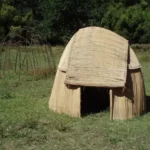Khoi camp museum
The word “Khoisan” is the collective name given to describe two separate indigenous groups of the South Western regions of Africa, namely the Khoi (aka Khoe) who were herders, and the San who were hunter-gatherers. They were scattered throughout the region into various tribes, each led by a traditional chief
Genadendal was originally established with the purpose of evangelizing to the Khoikhoi. Some of them ended up settling in the area after being forced out of the Cape by Dutch settlers.
Traditional dwellings that these nomadic people have built for centuries, were made from the plant Cyperus Textilis or Cape Papyrus. This grows all along the banks of the water streams in the Western Cape. Reeds are cut and stored until they are dry. The huts can be quickly broken down or rebuilt.
An oval beehive-shaped framework made of branches stuck into the ground, which was then tied together and covered with woven reed mats. The size of a hut varied depending on the size of the family living in it. The fibre in the reeds is tough and supple. The mats made from it can be rolled up and easily transported on the backs of oxen. In winter the reeds will swell and provide a watertight shelter, while in summer they will shrink and the huts are well-ventilated. Traditionally the reeds were pierced and woven together with the same material which was platted into string.
The missionaries encouraged the Khoi people to settle permanently on the mission station and to build permanent clay brick houses. They cultivated the land and enjoyed an enriched Christian education
Kerk St, Genadendal


